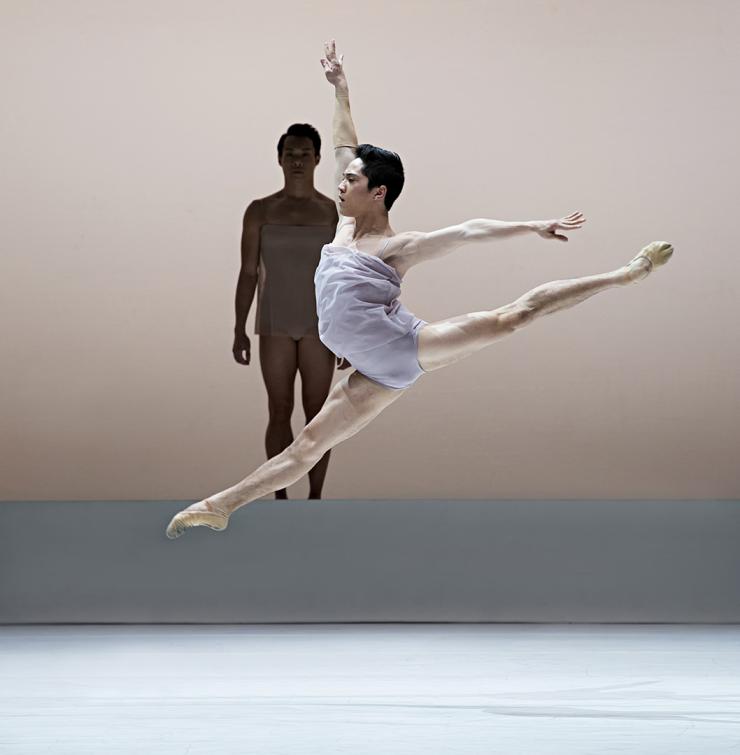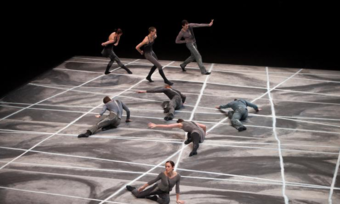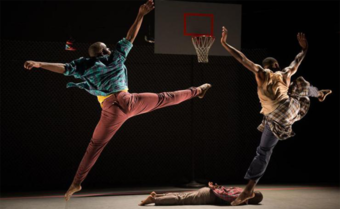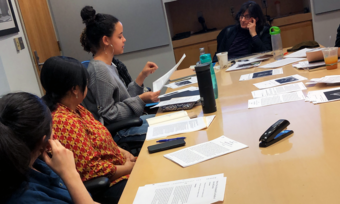Ballet and Time
“The most powerful theatrical essence remains, where it began, in the dance.”
This is Lincoln Kirstein, founder of the influential literary magazine Hound & Horn, the Harvard Society of Contemporary Art (an early forerunner of the Museum of Modern Art) and, in 1933, the man who brought choreographer George Balanchine to the United States in an effort to elevate dance in America from the vaudeville turn to the highest of cultural enterprise.
In 1934, the year that Balanchine and Kirstein founded the School of American Ballet, Balanchine created a new piece—in part to teach his American dancers about the fundamentals of staging. The piece is set to Tchaikovsky’s Serenade for Strings, and called Serenade. It takes as its prototype a 1924 ballet by Feodor Lopoukhov, Tanzsynfonia, that caused political tremor in Leningrad when it premiered in 1923. A young Balanchine had appeared in the ballet, which was an early example of the symphonist movement in dance: it required a full orchestra, a new innovation, and depended upon symphonic structure rather than an easily glossed story line. Tanzsynfonia was quickly censured in Leningrad: the piece was called an “impure” manifesto of decadence and bloodless incomprehensibility. In 1924, Loupoukhov choreographed Red Whirlwind, an extremely comprehensible ballet with a strong Bolshevik pretext.
This year, the Boston Ballet stages Serenade with another classic of the Balanchine repertory: Symphony in C, set to George Bizet, the first ballet produced under the auspices of Kirstein’s New York City Ballet in 1947. Completing the triple bill is a ballet by Wayne McGregor, resident choreographer of the Royal Ballet in London, that lends its title to the bill: Chroma.
Sitting in the Boston Opera House (the new home of the Boston Ballet after a fiasco with the Wang Center in 2009) one is struck by the strange coherence of this program. Ballet like Balanchine’s is pointedly paired with Chroma, which might mark a defining moment in McGregor’s development. His decisions here place him in the footsteps of the symphonist experiments of the early twentieth century. Again, we see a remarkable stripping away of plot and reliance on musical structure. As in European ballet in the 1920s, there is an expansion of the orchestra insisting upon the prominence of the score’s brash, cacophonous arrangements by Toby Jalbot (both of his own music and tunes by The White Stripes). And Chroma requires more instrumentalists than the Boston Ballet has ever had at once: percussionists are stationed in the balconies. Paired with this wall of sound is an extreme minimalism in the visual field of a space designed by the architect John Pawson. The look of the stage is both bright and subtle: not a return to baroque stage effects, but a reinvention of simplicity, on the order of the plain black space where Balanchine’s dances find extraordinary life.
Within this frame, the dancers move with the tense assurance of performers at groundbreaking work. It would be good of the Boston Ballet to provide more information about the individuals appearing in each movement, even in a piece like McGregor’s which flies by without time to reference the program. Lamentably, the ensemble is only listed alphabetically in the note, discouraging call-outs to the opening pas de deux by the uninitiated, but each of the performers is superb and distinct: a creature from another planet of super-articulated spinal columns and a more casual relationship with gravity. McGregor’s lifts are phenomenally entertaining. Duets and pas de trois bear varied relationships to the straight line, and the momentum and variety of vocabulary McGregor draws upon seems limitless. Interludes where dancers stand in neutral positions and walk colloquially, flat-footed, and without gesture lend sharp contrast to the cyclones of human anatomy that are each combination.

There is a risk, of course, that such work will appear dry, even didactic: an onslaught of movement, an onslaught of noise. It is a kind of entertaining but is this, truly, the most powerful theatrical essence? Much of McGregor’s work seems to shy from theatricality, bearing more interest in the problems of conceptual art and collaborations that encourage that association. At its least inhabited moments, this risks spectacle as well as incomprehensibility, illegibility as well as difficulty. But some interviews suggest a shift in the choreographer’s thinking. “I’m very interested in peppering the work with potentials, moments of narrative that keep giving some anchors for meaning,” Mr. McGregor told the New York Times in 2008, “but using those to distort perception.”
For those of us who consider theatrical problems, however, meaning as a distortion of perception might be a quite elementary trick, and a goal rather below the intelligence that Mr. McGregor betrays in the more admirable moments of his work. What Lincoln Kirstein wrote of Balanchine’s relationship to meaning, in Dance Index from 1945, was quite different and more adjusted in scope to the significant opera houses that Mr. McGregor hopes to fill.
When [Balanchine] reads a score all the musical elements, the components of counterpoint, harmony, rhythm and melody, are richly suggested to him, not as a series of Tableaux Vivants, but as sequence of spatial and mobile notions of anatomical relationships, less literary than melodic. An entrance, —a fanfare of movement, —a single exit, —a sweep emptying the stage, come forth as abstract compositional patterns used to support the music, or emphasize its break, silence, or recommencement, or for their own sake, or as part of the mysterious, hidden 'floor' of dancing, which is his orchestral score. His dance achieves a magic of its own; the exterior world is in comparison Shakespeare's unsubstantial world of images; and every apparently meaningless gesture has its proper significance, if not on the obvious level of logic, then on the profounder level of physical necessity or instinct.
Achievement of truth might be a greater imperative than the distortion of perception. This is a kind of argument for the impulse of preservation that is peculiarly strong in classical ballet, which sometimes appears stodgily conservative.” At a certain point in the history of Western subjectivity,” performance theorist Andre Lepecki wrote in TDR in 2007, embodying the argument, “a certain social (and socializing) activity called dance fell prey to a Stately (and theological) apparatus of capture called choreography.” This is true enough, and we have spoken already of the Stately interest in dance spectacle (it bears mention that McGregor choreographed pieces for the London Olympic Games in 2012), but one can only imagine what Lepecki would have to say about the enormous sacrifice and suffering required to perform ballets, and one would rather not imagine the enormous loss to be suffered by the performing arts if this genre of commentary were to discourage the remarkable human practice of training the body for years to perform a series of shapes, leaps, and extensions that seem worth the effort. Our arts are more new and fragile than we imagine, and probably more worth preserving: there are other organizing forces than the State.
Ballet is a strange experience of time out of time: one is transported to a moment that belongs to no one, not even the state.
In the elegant gestural life of a Balanchine ballet, choreography is clearly worth the struggle of systematization, just as performance is worth the struggle of training. In theoretical terms I cannot tell you why, but if you see the curtain rising on a stage filled with women in pale blue, their raised right palms slowly descending, I feel almost sure that you will feel a powerful theatrical essence, and know (this simple tableau drew applause when I attended). Ballet is a strange experience of time out of time: one is transported to a moment that belongs to no one, not even the state. And for Wayne McGregor, operating in the choreographic modus operandi of ballet, it means that his work must struggle join this timeless space. He recently said to the Boston Globe:
And I think perhaps there’s a connectedness. Balanchine was making work that was very off-center and strangely articulated, and challenging himself to play and experiment and invent. Everything feels so essential. You don’t look at a Balanchine piece and think, “Oh, if only he had done such and such.” You just don’t. And I find that about the best modern architecture, you feel it can only be that way, there’s no alternative. I guess that’s something I would aspire to do. I don’t think I’m there at all; I’m not comparing myself to Balanchine. But I would love to inherit some of those qualities.








Comments
The article is just the start of the conversation—we want to know what you think about this subject, too! HowlRound is a space for knowledge-sharing, and we welcome spirited, thoughtful, and on-topic dialogue. Find our full comments policy here